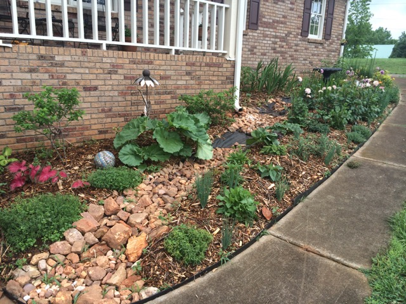
Creating an Edible Landscape
Article By Jessica Warren, ANR Agent, Camden County
Not everyone likes the look of, or has the space for, a traditional food production garden. Or perhaps you have a vegetable garden but would like a way to incorporate more edible plants into the space you have. Edible landscaping can be a great tactic for any of these situations. There are many types or categories of edible landscaping including foodscaping, permaculture, food forests and square-foot gardening. Regardless of these descriptors, edible landscaping is generally the practice of incorporating edible plants into the ornamental landscape following basic design principles. Edible landscaping often has a strong focus on perennials which are lower maintenance and provide a longer yield. Growing more food plants at home offers improved taste and nutrition, increased food security, convenience, sustainability, and exercise.

When creating an edible landscape, there are several things to consider. Will you be planting perennials, annuals, or a combination? Annuals will need to be removed and replaced throughout the seasons which may disturb or damage neighboring perennials. Whatever combination you choose – be certain that you aren’t utilizing any invasive plants. Keep in mind that pesticides and herbicides that may be safe for your lawn or ornamentals may not be safe for food plants. Consider that areas close to roads or sidewalks may be exposed to runoff, debris, and pollution that you may not want your food exposed to. Neighborhood dogs may also be attracted to plants adjacent to roads or sidewalks and see them as scent distributors. Make sure that you don’t plant in city right-of-ways or areas needed for utilities access (like a water meter). If you have an HOA, consider the plants and aesthetics that they allow. Accept and expect to share some of your harvest with insects and wildlife. A pesticide free landscape is the healthiest for you, your family, the ecosystem and waterways, pollinators, beneficial insects, and wildlife. The most important key to success, however, is planting the right plant in the right place. Choose plants that are appropriate for our USDA plant hardiness zone (8b-9a in Camden), and that require the sun and moisture/drainage that your planting site provides. Space plants according to their mature size, not the size they are when you purchase them. Group plants with similar moisture needs together, and site plants with the highest moisture requirements close to a water source. It is never a good idea to water the whole landscape with an equal amount of water and/or on a set schedule. Water should only be applied when needed to supplement inadequate rainfall, and only to the plants that actually need it.
There are several ideas and suggestions that may be useful to you when creating an edible landscape. You can maintain a healthy and full looking landscape by interspersing annuals with perennials and evergreens. Utilizing as many native plants as possible will reduce your labor and expense, while providing better resources to birds and pollinators. Use a variety of textures, heights, and sizes for interest, and repeat plants to create unity. Start planning utilizing a design theme or style to guide the layout of your edible landscape. Combine low-maintenance, reliable ornamentals with edible plants. Use evergreen ornamentals or edibles to maintain green structure throughout the seasons. Our native yaupon holly would be great for evergreen structure, berries for birds, and leaves for caffeinated tea. Use structures (arbors, trellises, tepees, tomato cages, etc.) for aesthetic appeal, proper growing practices, and to provide organization. They can create architectural interest as well as outdoor rooms or comfort zones in the landscape. Planters can be used to provide interest and organization. They are especially helpful in reigning in aggressive plants such as mint and lemon balm. Hard edges such as garden walls, wattle, borders, edging, and raised planters can create a clean appearance and organize your space. Pathways can provide access to plants while creating order and organization. Start small and grow over time so that you don’t become overwhelmed or rushed. Select plants that are visually appealing, easy to grow, and that you want to eat. Choose plants that offer multiple services. For instance, passionflower vine produces an edible fruit, leaves that can be brewed for tea, a beautiful flower, and it serves as the host plant for the Gulf Fritillary butterfly.
There are many plants that can be incorporated into an edible landscape from herbs to vegetables, to fruit trees. My favorite additions are low maintenance perennials. Some trees to consider incorporating are red mulberry (red mulberry is a wonderful native but please do not use the invasive white mulberry), pawpaw (native), loquat, yaupon holly (native), satsumas, native plum species, persimmon – native or Fuyu. Shrubs to consider include fig, elderberry (native), blueberry (some are native), pomegranate, rosemary, and sage. Desirable edible vines to incorporate include muscadine, sweet potato, passionflower vine (native), nasturtium, Malabar spinach, and beans. Edible groundcovers include thyme, oregano, savory, and strawberries (some are native). I would also encourage you to reconsider the “weeds.” Many of our wild native plants and others that are often considered weeds (remember a weed is any plant growing where you don’t want it to grow) are edible and nutritious. Some examples are greenbrier shoots, dandelion, Florida betony, wild garlic, yellow nutsedge, common blue violet, sheep’s sorrel, purslane, Asiatic hawksbeard, dollarweed, and Virginia Spiderwort.
Remember that not all parts of a plant with edibility are edible, and many aren’t edible raw. Never eat any plant without being 100% certain of its identity – some edible plants have toxic lookalikes. Do your research using credible sites (such as university sites) and peer reviewed books. Random blogs and Wikipedia are not credible sources.